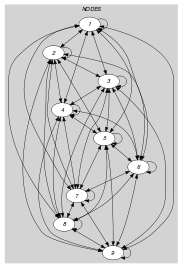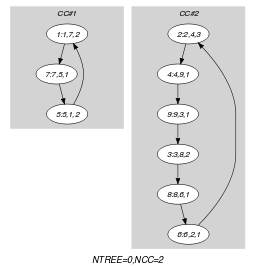5.104. cycle_card_on_path
| DESCRIPTION | LINKS | GRAPH |
- Origin
CHIP
- Constraint
- Arguments
- Restrictions
- Purpose
Consider a digraph described by the collection. is the number of circuits for covering in such a way that each vertex belongs to a single circuit. In addition the following constraint must also hold: on each set of consecutive distinct vertices of each final circuit, the number of vertices for which the attribute colour takes his value in the collection of values should be located within the range .
- Example
-
The constraint holds since the vertices of the collection correspond to a set of disjoint circuits and since, for each set of 3 (i.e., ) consecutive vertices, colour 1 (i.e., the value provided by the collection) occurs at least once (i.e., ) and at most twice (i.e., ).
- Typical
- Symmetries
Items of are permutable.
An occurrence of a value of that belongs to (resp. does not belong to ) can be replaced by any other value in (resp. not in ).
can be decreased to any value .
can be increased.
Items of are permutable.
- Usage
Assume that the vertices of are partitioned into the following two categories:
Clients to visit.
Depots where one can reload a vehicle.
Using the constraint we can express a constraint like: after visiting three consecutive clients we should visit a depot. This is typically not possible with the constraint since we do not know in advance the set of variables involved in the constraint.
- Remark
This constraint is a special case of the parameter of the constraint of CHIP [Bourreau99].
- See also
- Keywords
characteristic of a constraint: coloured.
combinatorial object: sequence.
constraint type: graph constraint, graph partitioning constraint, sliding sequence constraint.
- Arc input(s)
- Arc generator
-
- Arc arity
- Arc constraint(s)
- Graph property(ies)
-
- Graph class
-
- Sets
-
- Constraint(s) on sets
- Graph model
Parts (A) and (B) of Figure 5.104.1 respectively show the initial and final graph associated with the Example slot. Since we use the graph property, we show the two connected components of the final graph. The constraint holds since all the vertices belong to a circuit (i.e., 0) and since for each set of three consecutive vertices, colour 1 occurs at least once and at most twice (i.e., the constraint holds).
Figure 5.104.1. Initial and final graph of the constraint


(a) (b)